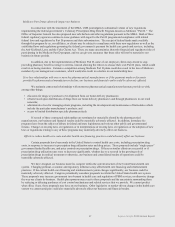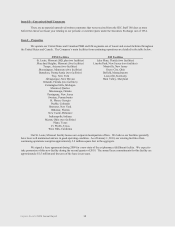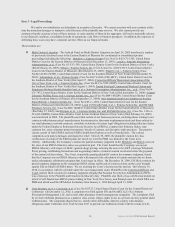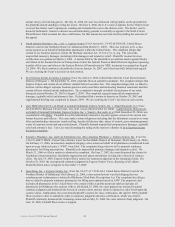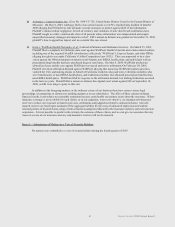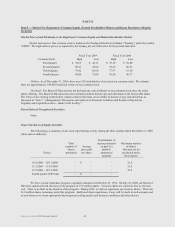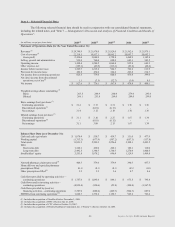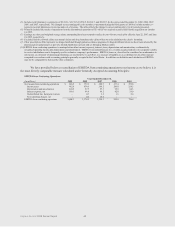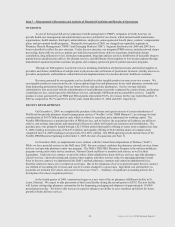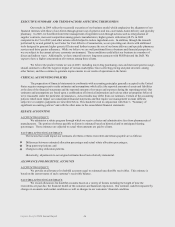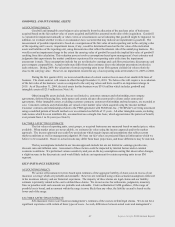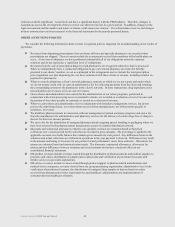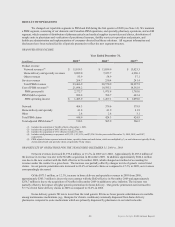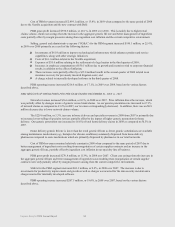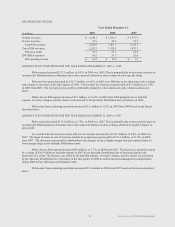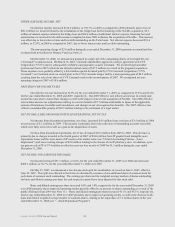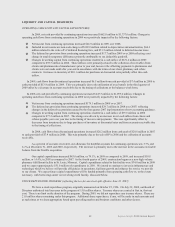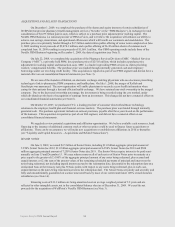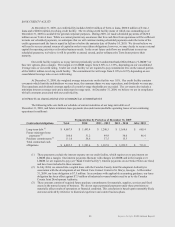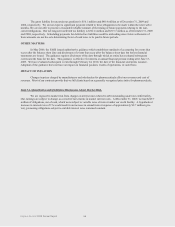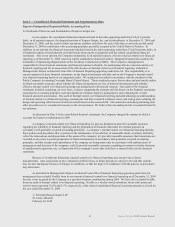Express Scripts 2009 Annual Report Download - page 49
Download and view the complete annual report
Please find page 49 of the 2009 Express Scripts annual report below. You can navigate through the pages in the report by either clicking on the pages listed below, or by using the keyword search tool below to find specific information within the annual report.
Express Scripts 2009 Annual Report
47
GOODWILL AND INTANGIBLE ASSETS
ACCOUNTING POLICY
Goodwill and intangible asset balances arise primarily from the allocation of the purchase price of businesses
acquired based on the fair market value of assets acquired and liabilities assumed on the date of the acquisition. Goodwill
is evaluated for impairment annually or when events or circumstances occur indicating that goodwill might be impaired. In
addition, we evaluate whether events or circumstances have occurred that may indicate an impairment in goodwill. The
measurement of possible impairment is based on a comparison of the fair value of each reporting unit to the carrying value
of the reporting unit’s assets. Impairment losses, if any, would be determined based on the fair value of the individual
assets and liabilities of the reporting unit, using discount rates that reflect the inherent risk of the underlying business. We
would record an impairment charge to the extent the carrying value of goodwill exceeds the implied fair value of goodwill
resulting from this calculation. This valuation process involves assumptions based upon management’s best estimates and
judgments that approximate the market conditions experienced for our reporting units at the time the impairment
assessment is made. These assumptions include but are not limited to earnings and cash flow projections, discount rate and
peer company comparability. Actual results may differ from these estimates due to the inherent uncertainty involved in
such estimates. During 2009, the valuations of certain reporting units in our EM segment yielded fair values relatively
close to the carrying value. However, no impairment existed for any of our reporting units at December 31, 2009 or 2008.
During the first quarter 2010, we received notification of a client contract loss in one of our smaller EM lines of
business. The client contract will remain in effect through December 31, 2010. We believe this will require a re-evaluation
of the fair value of the business’ assets as compared to the carrying values and there could be an impairment charge in
2010. As of December 31, 2009, the total assets for this business were $39.8 million which includes goodwill and
intangible assets of $23.9 million (see Note 14).
Other intangible assets include, but are not limited to, customer contracts and relationships, non-compete
agreements, deferred financing fees, trade names and certain advance discounts paid to clients under contractual
agreements. Other intangible assets, excluding customer contracts, customer relationships and trade names, are recorded at
cost. Customer contracts and relationships are valued at fair market value when acquired using the income method.
Customer contracts and relationships related to the PBM agreement with WellPoint, Inc. (“WellPoint") are being amortized
using a modified pattern of benefit method over an estimated useful life of 15 years. All other intangible assets, excluding
trade names which have an indefinite life, are amortized on a straight-line basis, which approximates the pattern of benefit,
over periods from 1 to 20 years (see Note 8).
FACTORS AFFECTING ESTIMATE
The fair values of reporting units, asset groups, or acquired businesses are measured based on market prices, when
available. When market prices are not available, we estimate fair value using the income approach and/or the market
approach. The income approach uses cash flow projections which require inputs and assumptions that reflect current
market conditions as well as management judgment. We base our fair values on projected financial information which we
believe to be reasonable. However, actual results may differ from those projections, and those differences may be material.
The key assumptions included in our income approach include but are not limited to: earnings growth rates,
discount rates and inflation rates. Assessment of these factors could be impacted by internal factors and/or external
economic conditions. We performed various sensitivity analyses on the key assumptions noting that absent other changes,
a slight increase in the discount rate used would likely indicate an impairment for certain reporting units in our EM
segment.
SELF-INSURANCE RESERVES
ACCOUNTING POLICY
We accrue self-insurance reserves based upon estimates of the aggregate liability of claim costs in excess of our
insurance coverage which are probable and estimable. Reserves are estimated using certain actuarial assumptions followed
in the insurance industry and our historical experience. The majority of these claims are legal claims and our liability
estimate is primarily related to the cost to defend these claims. We do not accrue for settlements, judgments, monetary
fines or penalties until such amounts are probable and estimable. Under authoritative FASB guidance, if the range of
possible loss is broad, and no amount within the range is more likely than any other, the liability accrual is based on the
lower end of the range.
FACTORS AFFECTING ESTIMATE
Self-insurance reserves are based on management’s estimates of the costs to defend legal claims. We do not have
significant experience with certain of these types of cases. As such, differences between actual costs and management’s


